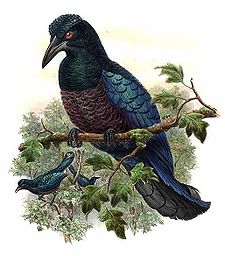- Curl-crested Manucode
-
Curl-crested Manucode 
Conservation status Scientific classification Kingdom: Animalia Phylum: Chordata Class: Aves Order: Passeriformes Family: Paradisaeidae Genus: Manucodia Species: M. comrii Binomial name Manucodia comrii
Sclater, 1876The Curl-crested Manucode, Manucodia comrii, is a compact and large, approximately 43 cm long, bird-of-paradise with glossy purple, black and green plumage, red iris and crinkled yellowish-green upper breast and neck feathers. It has curled head feathering and twisted central tail feathers. Both sexes are similar with a slightly smaller female. It is the largest species of Manucode, and also the largest species in its family in terms of body size[1], though its tail is shorter than the Black Sicklebill.
Endemic to Papua New Guinea, the Curl-crested Manucode is distributed to the Trobriand Islands and islands of the D'Entrecasteaux Archipelago. This species is also one of the largest and heaviest among birds of paradise. The diet consists mainly of fruits.
The British zoologist Philip Lutley Sclater named this species after Dr. Peter Comrie, who discovered the bird at Fergusson Island in 1874.
A common species in its limited habitat range, the Curl-crested Manucode is evaluated as Least Concern on the IUCN Red List of Threatened Species. It is listed on Appendix II of CITES.
References
- ^ Perrins, Christopher, Firefly Encyclopedia of Birds. Firefly Books. ISBN 1-55297-777-3
- BirdLife International (2004). Manucodia comrii. 2006. IUCN Red List of Threatened Species. IUCN 2006. www.iucnredlist.org. Retrieved on 30 October 2006. Database entry includes a lengthy justification of why this species is of least concern
External links
Birds-of-paradise (family: Paradisaeidae) Genera and species LycocoraxParadise-crowGlossy-mantled Manucode • Jobi Manucode, • Crinkle-collared Manucode • Curl-crested Manucode • Trumpet ManucodeArfak Astrapia • Splendid Astrapia • Ribbon-tailed Astrapia • Princess Stephanie's Astrapia • Huon AstrapiaWestern Parotia • Queen Carola's Parotia • Bronze Parotia • Lawes's Parotia • Eastern Parotia • Wahnes's ParotiaPteridophoraKing of Saxony Bird-of-paradiseLophorinaSuperb Bird-of-paradiseSemiopteraStandardwingSeleucidisTwelve-wired Bird-of-paradiseLesser Bird-of-paradise • Greater Bird-of-paradise • Raggiana Bird-of-paradise • Goldie's Bird-of-paradise • Red Bird-of-paradise • Emperor Bird-of-paradise • Blue Bird-of-paradiseIncomplete list of likely hybrids Astrapian Sicklebill • Barnes' Astrapia • Bensbach's Bird of Paradise • Blood's Bird of Paradise • Duivenbode's Bird of Paradise • Duivenbode's Riflebird • Duivenbode's Six-wired Bird of Paradise • Elliot's Bird of Paradise • False-lobed Astrapia • Gilliard's Bird of Paradise • King of Holland's Bird of Paradise • Lupton's Bird of Paradise • Lyre-tailed King Bird of Paradise • Mantou's Riflebird • Maria's Bird of Paradise • Mysterious Bird of Bobairo • Rothschild's Bird of Paradise • Rothschild's Lobe-billed Bird of Paradise • Ruys' Bird of Paradise • Schodde's Bird of Paradise • Sharpe's Lobe-billed Parotia • Stresemann's Bird of Paradise • Wilhelmina's Bird of Paradise • Wonderful Bird of ParadiseThis Paradisaeidae-related article is a stub. You can help Wikipedia by expanding it.

